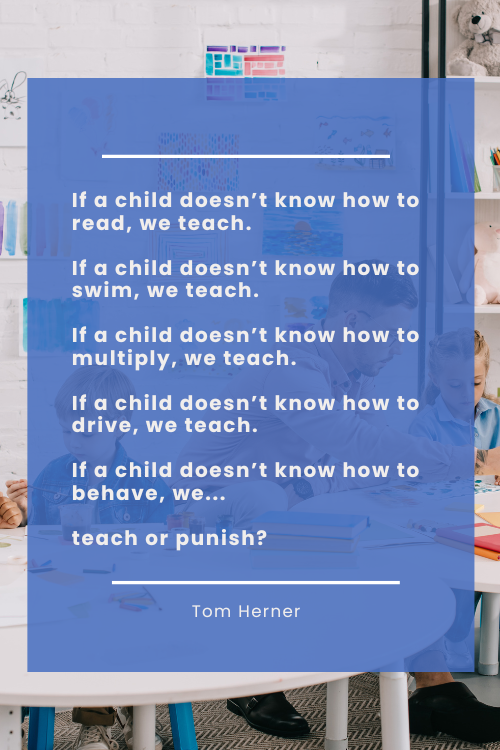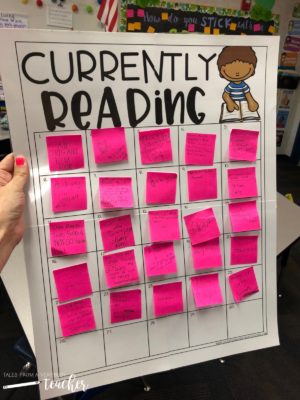Managing classroom behaviors is probably one of the toughest parts of being a teacher. I have tried almost every strategy in my classroom and what I have found that works best is being consistent, logical, and understanding with my students by using clear behavior expectations and logical consequences.
What really helped me shape my thinking when it came to managing behaviors and my classroom was thinking about problem behaviors as learning errors. This quote from Tom Herner says it perfectly.

Sometimes, when it comes to problem behaviors, we select interventions that produce immediate relief:
- remove student
- remove ourselves
We often times (and not intentionally) forget that some of our students are exposed to inescapable, overwhelming stress, which may seek our attention in all the wrong ways. This can lead us to punish them, rather than teach them.
If only we knew what happened last night, or this morning before he/she got to school, we would be shielding the same child we’re now reprimanding.
It’s important to remember that behavior serves a purpose, also known as a function.
That function is communicative:
- The student is trying to tell you something
- The student has learned that engaging in such behavior will get his/her needs met
When we look at behavior from this perspective, it can help us develop consequences that are more logical rather than punitive.
What are logical consequences?
Logical consequences respond to the behavior of the child and send the message that there is an issue with the behavior, not the child. Logical consequences are tied to the misbehavior which means a student is being taught to change their behavior, instead of just receiving a punitive punishment.
For example, if a student did finish their classwork, taking away their recess time would NOT be a logical consequence.
What are examples of logical consequences?
In order to create logical consequences for students’ misbehavior, it’s important to understand the Three R’s of Logical Consequences:
- Relevant
- Realistic
- Respectful
Consequences need to be relevant.
In order for students to make a connection between the behavior and the consequence it’s important that the 2 are tied closely together. For example, if a student gets into arguments on the basketball court and is unable to play fairly, after knowing and understanding the expectations of the game, they may have to take a break from basketball for a little bit. Another consequence of this action could be that the student has to show they can follow expectations in a game of basketball with other students/recess before engaging in the same recess again.
Consequences need to be reasonable.
A reasonable consequence means that the duration of the consequence makes sense. Taking away the game of basketball for a student for one month is not a reasonable amount of time. It may take just sitting out of one game to help the student reset and practice the correct behavior expectations in the next game.
Consequences need to be respectful.
Logical consequences are designed to provide students with an opportunity to learn from their mistakes, not lower their self-esteem. Use simple, concise, factual language and avoid negative emotions so students don’t get embarrassed or become defensive.
It’s more than just logical consequences.
In order to have logical consequences be relevant, reasonable, and respectful, you’ll also need to have positive behavior expectations students can refer to and that you can utilize when preparing logical consequences. If students are explicitly taught expectations and can use those expectations to assess their own behavior, then the logical consequence can be that much more effective.
In addition to having logical consequences, it’s important that students understand the purpose of the consequence and why they’re receiving that consequence. When you are able to communicate this clearly to your students then you open the door of communication, trust, and respect.
Examples of Misbehaviors and Logical Consequences
It’s important to keep in mind logical consequences will look different for each student. It’s dependent on the student’s goals, the misbehavior that occurred, and the function of that behavior. These logical consequences that are listed are general, but should be tailored to meet each individual student’s needs.
You Break It, You Fix It
This logical consequence happens when students take responsibility for their actions.The consequence is fixing the problem that was created. This consequence must be tied directly to the behavior.
Examples:
- One child accidentally knocks into another on the playground. She stops, apologizes, and offers to help the other child get up.
- A student knocks over a tray of food carried by another student. He helps clean it up and perhaps offers to go back and get new food.
- A child hurts the feelings of another. She participates in “an apology of action” by writing a note, including the hurt child in a friendly activity
Loss of Privilege
This logical consequence happens when the student’s behavior does not meet the expectation. The consequence is the student losing a privilege of participating in something or using materials for a brief time. This consequence must be directly related to the misbehavior.
Examples:
- Two children talk instead of working. They have to sit by themselves.
- A student plays unsafely on an outdoor structure. She has to choose a different area of the playground to use during the rest of that recess.
- A student fools around online. They have to walk with the teacher.
Time Out/Take a Break
This consequence gives students, who might be losing control of themselves, a break. They are able to use this break to regain control and are ready to participate again following behavior expectations.
Students might need a break when:
- Calls out, denying others a chance to think
- Refuses to do work
- Ignores the quiet signal
- Persists in a negotiation with the teacher
Things to Keep in Mind
- Every week starts with a clean slate
- Take concrete action to correct behavior, i.e. individual practice, removal from activity, seat change, other logical consequences
- Teachers are encouraged to use preventative strategies to prevent student misbehavior
- Continually refer to the school-wide and classroom behavior expectations
Logical consequences and setting behavior expectations are also more effective when you have a strong administration team and a principal who supports you. Your principal needs to be there to support this effort as well as build a relationship with the students so they can help with logical consequences and behavior plans.




